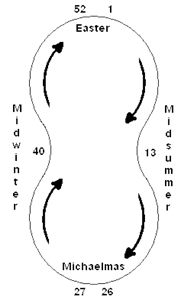 Ruth & Hans Pusch
Ruth & Hans Pusch
|
Translation
of Rudolf Steiner's Calendar of the Soul
Rudolf Steiner's Calendar of the Soul
by Ruth & Hans Pusch.
Copyright 1982 The Anthroposophic Press)
Included in Volume 40 of the Bibliographical Survey
1961.
Preface to the Second Edition (1918)
The course of the year has its own life. With this life the human soul
can unfold a feeling-unison. If the soul opens itself to the influences
that speak so variously to it week by week, it will find the right perception of
itself. Thereby the soul will feel forces growing within
that will strengthen it. It will observe that such inward forces want to be awakened — awakened by the soul's ability to partake in the
meaningful course of the world as it comes to life in the rhythms of time. Thereby the soul becomes fully aware of the delicate, yet vital
threads that exist between itself and the world into which it has been
born.
In this calendar a verse is inscribed for each week. This will enable the soul to participate actively in the progressing life of the year as it
unfolds from week to week. Each verse should resound in the soul as it unites with the life of the year. A healthy feeling of
"at
one-ness" with the course of Nature, and from this a vigorous "finding of
oneself" is here intended, in the belief that, for the soul, a feelingunison
with the world's course as unfolded in these verses is something for which the soul longs when it rightly understands
itself.
Rudolf Steiner
Corresponding Verses of the Calendar of the Soul
It is apparent that the Calendar of the Soul is composed of corresponding verses
which divide the year into two halves, from Easter to Michaelmas, and back again to
Easter. For the translator, the most important task is to bring the corresponding verses
into harmony with each other. By printing them side by side, each verse can be
experienced with its ‘octave’ of the corresponding one.
But something else comes to
expression in letting them speak side by side. Their relationship follows a
certain law of evolution. Out of the whole evolve the parts, and
this is the meaning of subtraction. We number the verses from 1 to 52 according to the
weeks of the year, Easter to Easter. And now a double subtraction has to take
place. We have one verse, say Number 5 for the fifth week; to find its correspondence, we
must subtract 1 from our 5, which leads to 4 ... and then subtract the 4 from 52,
resulting in 48, the verse we are looking for. It is necesssary each time to subtract from
the verse number and then from the whole.
This tracing of the related weeks is a gesture akin to the process of evolution. Out of
the majestic un-folding of macrocosmic forces, the microcosmic worlds came into
being. We ourselves followed this same process of subtraction by evolving by degrees
the consciousness of self. It was a process of diminution by which we slowly
exchanged our ancient clairvoyant vision, embracing totality, for our present earthbound
sight and mind, geographically conditioned by the existence in a physical
body.
Subtracting means, therefore, on the one hand a diminishing, but on the other it
creates a new principle of evolution, that of polarity. Not only are the parts a contrast
to the whole, but also the parts themselves form opposites. There is no better
description of the process than the one Emerson gave in his essay "Compensation:"
"Polarity, or action and reaction, we meet in every part of nature; in darkness and
light; in heat and cold; in the ebb and flow of waters; in male and female; in the
inspiration and expiration of plants and animals; in the systole and diastole of the
heart; in the centrifugal and centripetal gravity ... If the south attracts, the north
repels. To empty here, you must condense there. The value of the universe contrives
to throw itself into every point. If the good is there, so is the evil; if the affinity, so the
repulsion; if the force, so the limitation ... Thus is the universe alive. All things are
moral. That soul which within us is a sentiment, outside of us is a
law." What lived in
Emerson's mind underlies the style and composition of these weekly verses. And it is
the human being who must reach a stage of compensation, of balance between the
opposites, enhancing the polarities to forces of inner growth and maturity.
It is a most
invigorating development when it is practiced year after year in faithful succession.
By combining the two corresponding verses in the mind, we gain a new insight into
the workings of that which is outside and that which lives within.
Hans Pusch
The dates above the verses relate to the manuscript of the first edition, which covered the
year 1912-1913. When he was questioned about the change of dates that occurs from year
to year, Rudolf Steiner stressed that one must always begin with the first verse at Easter.
Thus, the change in dates is not important because three successive verses of the Calendar
are always kept in the same mood.
|
|